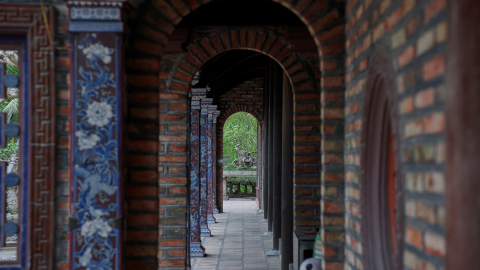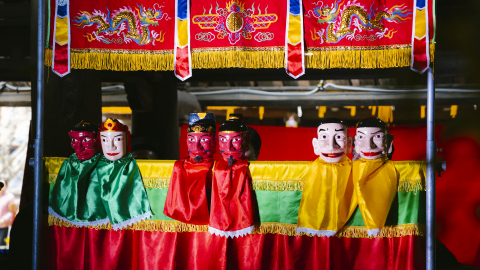The journey of nearly a century of the “Holy Land”
Arriving at Hoa Thanh town, from afar, visitors can see the Holy See towering in the vast sky. In the middle of a peaceful land, this place has become a symbol of a purely Vietnamese religion, born in the early 20th century and quickly spread throughout the South.
The construction of the project began in 1931, when the Cao Dai religion had just begun to take shape. Unlike other large projects, the Holy See was not meticulously sketched out with technical drawings. The ancients said that architecture was born from a “vision” - a spiritual inspiration that was recorded by dignitaries and then communicated to craftsmen. Therefore, the Holy See bears within itself a strange mark: both massive, symmetrical, and as if crystallized from spiritual inspiration.


Panoramic view of the main architectural complex of the Cao Dai Holy See in Tay Ninh
Related articles
After many years of construction, the project was basically completed in 1947, and officially inaugurated in 1955. Since then, through the vicissitudes of time, the Holy See has almost kept its original appearance, only repairing minor damages. For Cao Dai followers, this place is not only a "Holy Temple" but also a living proof of the desire for harmony between the universe and humanity.
East - West harmony in a majestic architecture
The architecture and details of the Holy See are a subtle blend of many styles in the same whole. People often compare the Holy See to "a dragon horse facing the West", because the entire structure is nearly 100 meters long, more than 20 meters wide, with two bell towers and a drum tower rising high like a pair of horns of a mascot.


From the outside, the brilliant combination of yellow, blue, and pink colors makes the entire architecture stand out like a mythical palace. The curved roof has the appearance of an Asian pagoda, but the long corridor and arched doors evoke the image of a European church. Interspersed with decorative details reminiscent of Indian temples, dragon and phoenix reliefs, and lotus flowers are imbued with Vietnamese identity. That is the spirit of Cao Dai: absorbing the beauty and quintessence of many religions and cultures to create a new harmony.

The architecture of the Vatican is a harmony of many cultures and beliefs.
Passing through the main gate, visitors walk along the main axis to enter the main hall. On both sides are rows of colorful painted dragon columns, the dragons' bodies winding as if they are flying, both solemn and lively. The ceiling of the hall is painted with a blue sky with white clouds and thousands of stars. The main hall is divided into nine sections, symbolizing nine heavens, each with six dragons entwined together, reigning on the ceiling of the hall. Each step takes people as if they are lost in a miniature universe, where the earthly world and the heavenly world meet.

The main hall inside the basilica is divided into nine spaces symbolizing the nine heavens.



The focal point of the entire shrine is the Divine Eye - the Eye of God placed on the cosmic sphere. The eye is wide open, looking forward, symbolizing the omniscient, omniscient God. The sphere is dotted with thousands of small stars, symbolizing all living things in the world. Standing before this symbol, visitors cannot help but feel small in the vast universe.

The Divine Eye symbolizes the eyes of God placed on the cosmic sphere placed in the main hall.


Not only the main hall, the Holy See complex also includes more than 100 auxiliary structures: Bat Quai Dai, Cuu Trung Dai, Nghinh Phong Dai, along with bell towers, drum towers, halls and tunnels. Each architecture has its own meaning, contributing to creating a grand and unified whole. In particular, the entire campus is surrounded by 12 gates, each gate depicting the Four Sacred Animals and lotus flowers. This is not only an aesthetic highlight, but also symbolizes protection and purification before entering the sacred land.


Space of ritual and spiritual life
If the architecture creates the splendid appearance, then the ritual is the soul that makes the Holy See come alive every day. Four ceremonies are held regularly: morning, noon, afternoon, and evening. In the solemn space, the believers kneel properly, singing in harmony with the chanting. The solemn sounds of drums, bells, and ritual music resound, making the entire hall seem to be immersed in a never-ending spiritual flow.


Every year, there are two major festivals that make the Holy See a gathering place for tens of thousands of believers. The first is the Great Festival of the Supreme Being on the 8th day of the first lunar month, commemorating the founding of the religion, when a solemn atmosphere pervades from inside to outside. The second is the Yao Chi Palace Banquet on the 15th day of the eighth lunar month, bustling with flower float processions, dragon dances, and feast offerings, reenacting the concept of the harmony of yin and yang. On these occasions, the Holy See is not only a place of worship, but also becomes a giant stage of beliefs, culture, music, and performing arts.
Ms. Kim Ngan, owner of a shop selling ao dai to Cao Dai followers for more than 30 years in Tay Ninh, shared that when participating in the ceremony, Cao Dai followers wear white ao dai, while dignitaries wear yellow, blue, and red robes. Each position has its own costumes and accessories.




Ms. Kim Ngan, owner of a shop making ao dai for Cao Dai followers for more than 30 years in Tay Ninh
The Holy See in the eyes of travelers
Coming to the Holy See, visitors not only admire a unique architectural work, but also step into the story of a purely Vietnamese religion. Amid the harsh sun and wind of Tay Ninh, the brilliant colors of the Holy See seem to shine brighter. The solemn sound of bells echoes through the space, mixed with the rustling of leaves, awakening all senses.
Walking down the long corridor, feeling the coolness of the bricks and stones, touching the smooth dragon pillars, one can clearly see the talented hands of the unknown artisans. Standing under the cloudy sky, looking up to see the Eye of Heaven, many people realize: the architecture here is not just for viewing, but for dialogue, to remind of the smallness of human beings and the desire to reach for the light.

The architecture of the Holy See shows the talent of the artisans and followers of Cao Dai religion.
Those who have time to linger longer will see the Holy See change from moment to moment. In the morning, the sunlight makes the five-colored tiled roof sparkle like gold. At noon, during mass, the atmosphere becomes unusually quiet and solemn. In the afternoon, the sunlight slant through the arched door, casting long shadows of the dragon columns on the tiled floor. And when night falls, the Holy See is immersed in warm yellow light, like a legendary castle emerging in the darkness.
More than nine decades have passed, and the Cao Dai Holy See of Tay Ninh still stands there, resplendent and majestic. Amidst the hustle and bustle of modern life, the Holy See still resonates with a symphony of architecture and spirituality, reminding us of the power of faith and the harmony of all living things.

 EN
EN



































